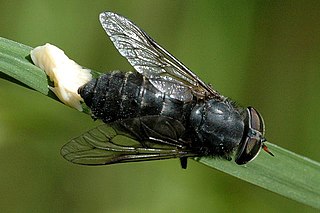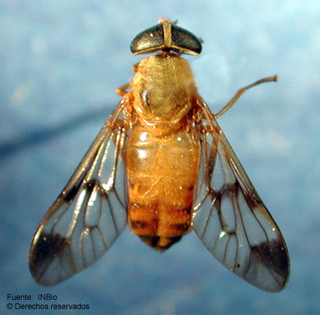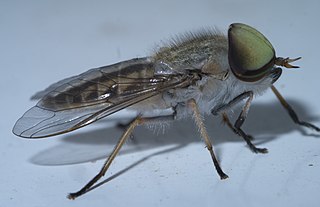
Horse-flies or horseflies are true flies in the family Tabanidae in the insect order Diptera. They are often large and agile in flight, and the females bite animals, including humans, to obtain blood. They prefer to fly in sunlight, avoiding dark and shady areas, and are inactive at night. They are found all over the world except for some islands and the polar regions. Both horse-flies and botflies (Oestridae) are sometimes referred to as gadflies.

Hybomitra is a genus of horse flies in the family Tabanidae. There are at least 240 described species in Hybomitra.

Diachlorus ferrugatus, commonly known as the yellow fly in the United States or doctor fly in Belize, is a species of highly aggressive biting horse-fly of the family Tabanidae native to North and Central America to Costa Rica.
Leucotabanus annulatus is a species of horse flies in the family Tabanidae. Larvae inhabit termite nests.

Tabaninae is a subfamily of horse flies in the family Tabanidae. There are more than 3000 described species in Tabaninae.

Tabanini is a tribe of horse and deer flies in the family Tabanidae. There are at least 220 described species in Tabanini.
Hybomitra trepida is a species of horse flies in the family Tabanidae.
Chrysops surdus is a species of deer fly in the family Tabanidae.
Haematopota rara is a species of horse flies.

Chrysopsinae is a subfamily of deer flies in the family Tabanidae.
Atylotus palus is a species of horse flies in the family Tabanidae.
Atylotus tingaureus is a species of horse flies in the family Tabanidae.
Anacimas limbellatus is a species of horse flies in the family Tabanidae.
Chrysops proclivis is a species of deer fly in the family Tabanidae.
Hybomitra sonomensis is a species of horse flies in the family Tabanidae.
Goniops is a genus of horse and deer flies in the family Tabanidae.
Tabanus punctifer, the western horse fly, is a species of horse fly in the family Tabanidae. This species of horse fly is approximately 20.5 mm long. They are typically found throughout the southern and western parts of the United States. They can be found between Utah and Mexico, and between California and Texas. The thorax is covered with long hairs that give it a creamy white color, while the abdomen is completely black. Much like other horse fly species, the Tabanus punctifer female requires a blood meal for the development of their eggs. Females will bite horses, livestock, and humans, making them vectors of disease for pathogens and parasites.
Hybomitra melanorhina is a species of horse flies in the family Tabanidae.
Hybomitra astuta is a species of horse flies in the family Tabanidae.
Anacimas dodgei is a species of horse flies in the family Tabanidae.






